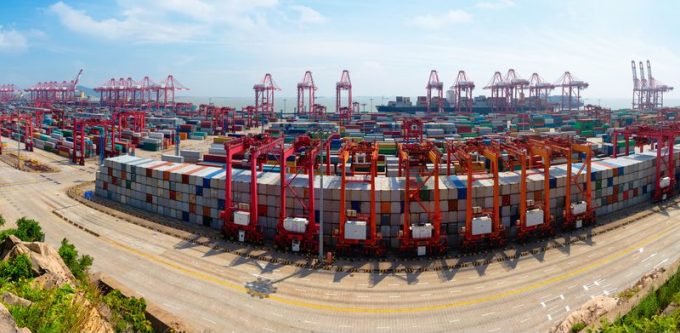Container spot rates have peaked as all major trades see prices fall
There was more evidence in this week’s container port freight markets that peak prices on ...
TFII: SOLID AS USUALMAERSK: WEAKENINGF: FALLING OFF A CLIFFAAPL: 'BOTTLENECK IN MAINLAND CHINA'AAPL: CHINA TRENDSDHL: GROWTH CAPEXR: ANOTHER SOLID DELIVERYMFT: HERE COMES THE FALLDSV: LOOK AT SCHENKER PERFORMANCEUPS: A WAVE OF DOWNGRADES DSV: BARGAIN BINKNX: EARNINGS OUTODFL: RISING AND FALLING AND THEN RISING
TFII: SOLID AS USUALMAERSK: WEAKENINGF: FALLING OFF A CLIFFAAPL: 'BOTTLENECK IN MAINLAND CHINA'AAPL: CHINA TRENDSDHL: GROWTH CAPEXR: ANOTHER SOLID DELIVERYMFT: HERE COMES THE FALLDSV: LOOK AT SCHENKER PERFORMANCEUPS: A WAVE OF DOWNGRADES DSV: BARGAIN BINKNX: EARNINGS OUTODFL: RISING AND FALLING AND THEN RISING

Ocean carriers are preparing for a return to fully booked ships.
The recovery in China’s manufacturing is reported to be up to around 80% of pre-new year levels, and regional transport movements are also getting back up to speed, it seems.
“We have seen many terminals and depots returning to normal operations,” said OOCL. “The reefer plug shortage issue in Shanghai, Tianjin and Ningbo has also gradually improved and more trucking services have resumed.”
The carrier’s view was supported by online freight marketplace Freightos, which reported this week that manufacturing in China had taken “definite steps” towards normality.
And on the intermodal situation, Freightos said: “Inter-province trucking, which last week was a major pain point, is now operating at about 80% capacity as well.”
The Shanghai Containerized Freight Index (SCFI) commentary this week reported vessel utilisation levels of 75%-80% for Europe and around 70% for US sailings.
Carriers have been obliged to withdraw almost half of scheduled capacity on both the Asia-Europe and transpacific tradelanes since the Chinese new year on 25 January, which analyst Sea-Intelligence estimates at some 1.9m teu.
This radical action could have cost the container lines around $2bn in lost revenue, according to the analyst, although carriers appeared to have succeeded in protecting spot rates from any serious erosion during the worst of the virus crisis.
In fact, the North Europe component of today’s SCFI recorded a 3.2% uplift, to $830 per teu, while for Mediterranean ports, there was a slight decline of 1.4%, to $915 per teu.
Carriers are in the process of preparing to raise FAK rates later in the month, as they look to recover severe losses incurred in the first quarter.
The knock-on effect of the blanked sailings from China has caused a major problem for Europe’s exporters. Firstly, shippers with cargo already delivered to container terminals are having to wait weeks before loading, and secondly, acute equipment shortages at depots, caused by the absence of import cargo box returns, has resulted in some carriers refusing bookings altogether.
Nevertheless, The Loadstar has seen wave after wave of North Europe-Asia ‘peak season surcharge’ (PSS) announcements from carriers in the past two weeks, which has driven a spot rate spike of 24% in the past week, to $786 per 40ft, according to Drewry’s WCI index.
“Not only can we not make any bookings due to our carriers rationing equipment, but when we eventually do, who knows what the PSS will be,” said one UK forwarder.
And Flexport’s head of ocean freight for Europe, Martin Holst-Mikkelsen, told The Loadstar storms hitting North Europe last month had also contributed to export delays.
“The stormy weather led to a growing backlog of containers waiting to be exported at sea terminals, prompting the introduction of restricted delivery slots,” said Mr Holst-Mikkelsen.
On the transpacific, spot rates as recorded by the SCFI were virtually unchanged this week for US east coast ports, at $2,679 per 40ft, while for the west coast, rates edged down 2.4% to $1,361 per 40ft.
“Rate increases announced for 1 April show carriers expect a slow March, followed by a strong April and beyond,” said Freightos.
Comment on this article